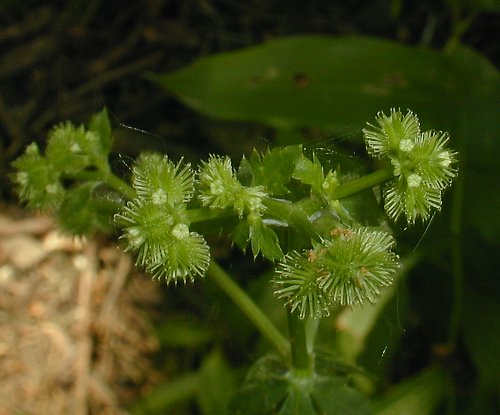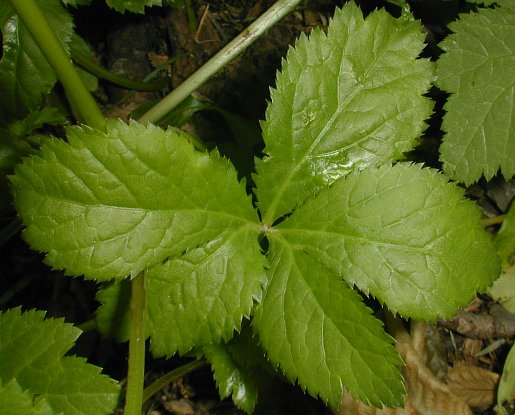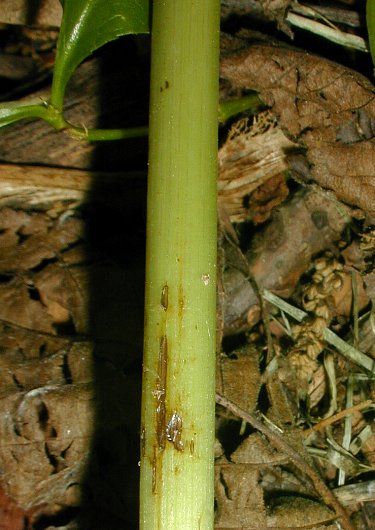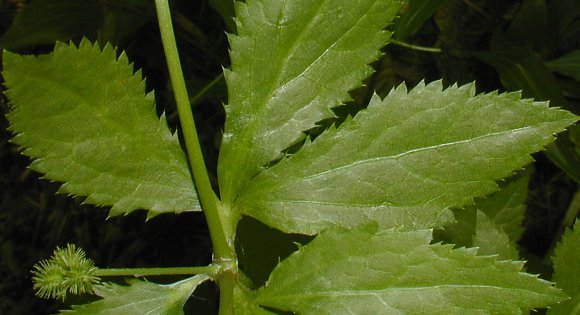Description: This herbaceous plant is a biennial or short-lived perennial; it is about 1-2' tall, branching occasionally. The stems are glabrous and light green; they are terete or somewhat angular. The alternate leaves are usually trifoliate, although some of the smaller upper leaves are simple. The lower leaves often appear to be palmate with 5 leaflets, but this is because each lateral leaflet has been deeply divided into 2 large lobes. In outline, the lower compound leaves are nearly orbicular in outline (up to 5" wide and 5" across, excluding the petioles) while the upper compound leaves are more narrow. The leaflets and large lobes are obovate, ovate, or broadly elliptic in shape, while their margins are coarsely double-serrated and sometimes cleft along their margins. Leaf venation within each leaflet and lobe is pinnate. The upper leaf surface is yellowish green (in bright sunlight) to dark green (in shade) and glabrous. The lower leaves have long petioles, while those of the upper leaves are much shorter. These petioles are light green, glabrous, and slightly sheathed at their bases; they are grooved above and convex below.

The upper stems terminate in small umbels or compound umbels of greenish white flowers. Each umbel consists of 1-4 umbellets and spans up to 2½" across. Each umbellet has 2-3 pistillate or perfect flowers and about 2-6 staminate flowers (less often, there will be 7-15 staminate flowers); these flowers form a tight cluster that is irregularly globular in shape. The perfect and pistillate flowers are more conspicous because of their bur-like ovaries. These ovaries are about 3-5 mm. in length, globoid-ovoid in shape, and green; their outer surfaces are covered with hooked prickles (about 1 mm. in length). Each flower has 5 greenish white petals and a green calyx with 5 linear-lanceolate lobes; these lobes are shorter than the prickles of the ovaries. The styles of perfect and pistillate flowers (less than 1 mm. in length) are also shorter than the prickles of the ovaries. Each staminate or perfect flower has 5 short stamens.

The
blooming period occurs from late
spring to mid-summer and lasts about 3 weeks for a colony of plants.
There is no noticeable floral scent. Each bur-like fruit contains 2
seeds. The root system is fibrous. This plant spreads by reseeding
itself and it occasionally forms colonies.
Cultivation:
The preference is light to medium shade, moist to slightly dry
conditions, and a loamy soil with an abundance of organic matter.
Range & Habitat:
Canadian Black Snakeroot is a common plant that occurs in nearly all
counties of Illinois (see Distribution
Map), where it is native. Habitats include mesic deciduous
woodlands, north-facing bluffs, areas along woodland paths, edges of
shaded seeps, fence rows with woody vegetation, edges of yards
underneath trees, and flower gardens in shady areas. This plant occurs
in both natural habitats of varying quality and disturbed areas.

Faunal
Associations:
The flowers attract few insect pollinators, although occasionally they
are visited by Halictid bees (Lasioglossum
spp.), masked bees (Hylaeus
spp.), and Syrphid flies, which suck nectar. An aphid, Aphis clydesmithi,
sucks plant juices at the stem base and root collar, while another
aphid, Aphis saniculae,
sucks plant juices from the undersides of the leaves. Canadian Black
Snakeroot is the preferred host plant of the latter aphid. The bitter
foliage is avoided by grazing livestock and probably other mammalian
herbivores as well. The small burry fruits cling readily to the
feathers of birds, fur of mammals, and clothing of humans; this helps
to distribute the seeds far and wide.
Photographic Location:
Underneath a lawn tree in Urbana, Illinois.

Comments: Canadian Black Snakeroot is not very showy, in part because it does not bloom until after the deciduous trees in woodlands have developed their leaves. Except for the bur-like ovaries, the flowers are inconspicuous. This species is well-adapted to the shady conditions that exist underneath trees during the summer, and it can become a minor weed along the edges of yards and in flower gardens. Except for Sanicula gregaria (Clustered Black Snakeroot), which has greenish yellow flowers, the various Sanicula spp. in Illinois have small greenish white flowers. The species of this latter group are rather difficult to distinguish. Canadian Black Snakeroot differs from Sanicula marilandica (Maryland Black Snakeroot) by its short styles, which are no longer than the prickles of its ovaries; the latter species has pairs of curved styles that are much longer than the prickles of its ovaries. Canadian Black Snakeroot differs from Sanicula trifoliata (Large-Fruited Black Snakeroot) by the size and shape of its burry fruits: The fruits of the former species are 3-5 mm. long and ovoid-globoid in shape, while the fruits of the latter species are at least 5.5 mm. in length and ovoid in shape. Furthermore, the calyx lobes of the latter species are as long or longer than the surrounding prickles, and its stamens are longer and more conspicuous than those Canadian Black Snakeroot.